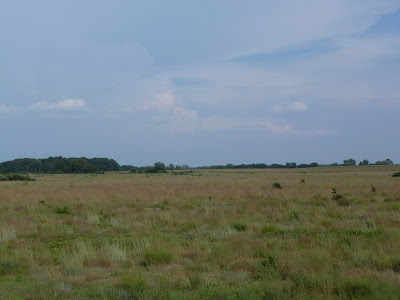 |
| Male Bobolink. Photo by Bill Hubick. |
Well, it’s a bird and a fascinating one at that. The Bobolink,
Dolichonyx oryzivorus, is a songbird in
the blackbird family (Icteridae). As you can see from the pictures to the right and below, males
and female are sexually dimorphic in the spring and summer months when the male
has unmistakable black and white plumage with a straw colored nape. The female
retains cryptic coloration year-round which is made up of straw colored body
plumage with black streaking on the flanks.
Bobolinks are long distant migrants traveling thousands of miles
annually from their breeding grounds in North America to their wintering
grounds in South America, roughly 6000 miles one way!!! Males not only have
unique plumage, but have a very unique song, follow this link to hear what they
sound like, http://www.xeno-canto.org/sounds/uploaded/CDTGHVBGZP/BOBO2007-6-3-2.mp3,
recorded by Andrew Spencer. Some people
think they sound like R2-D2 from Star Wars.
 |
| Female Bobolink. Photo by Bill Hubick. |
Bobolinks require grasslands or something very similar, like
alfalfa or hay fields, in which to nest. They can be found in Maryland during
migration in both spring and fall and they breed in western and northern counties
in the state. Maryland is at the very southern end of the breeding range for
Bobolinks. They don’t breed on the eastern shore, but some attempt to nest in
the northern reaches of Cecil County in hay fields.
Bobolinks have experienced range-wide population declines
due to a variety of reasons, with habitat loss considered the single biggest
factor. Most native grasslands and wet meadows have disappeared and they have
been forced to nest in crop and hay fields as a result. In terms of habitat quality, hay fields are
not bad, but the problem is harvesting the hay while birds are still nesting.
Farmers need to cut the hay at its nutritional peak which is often prior to young
birds fledging or when they are still too young to fly. Biologists, especially
in Vermont, are working with farmers to delay the cutting to allow nests to
fledge.
 |
| Adult male Bobolink in breeding plumage. |
Many Bobolinks use the CRFRS restored grassland on Chino
Farm as stopover and refueling site during spring migration. But, the best time
to see them in the grasslands is July through September. Adult males arrive
first, still in their distinctive breeding plumage, followed by adult females
and then in August and September by the young of the year. The restored
grasslands provide critical habitat for the Bobolinks that stop here in the
fall. Not only do the grasslands provide a bounty of food, in the form of
insects and unlimited grass seed, but the tall thick fields act as a refuge.
Bobolinks are somewhat unique among east coast birds in that they do not molt
on their breeding grounds or the wintering grounds, but rather somewhere in
between. This is where the restored grasslands are important.
+wing+molt+07-23-07.jpg) | ||||||||
| Adult male Bobolink undergoing flight feather molt. |
Molt is the process of feather replacement that all birds
under take annually. Soon after the adult Bobolinks arrive in the grasslands
they begin the pre-basic molt which is complete, meaning they will molt, or
replace, all their feathers. Only after this molt is complete in about 3-4 weeks
will these birds continue their south-bound migration. All Bobolinks will again
undergo a complete molt prior to leaving their wintering grounds for their spring
migration back north. Flocks of over 300 individuals have been seen in the
fields. What we don’t know yet is whether the same individuals use the
grasslands as a molting ground every year or whether we always see different
individuals. There are only two bird species in North America that go through
two complete molts each year, Bobolinks are one of them, do you know what the
other species is?
 |
| Sweeping views of the CRFRS restored grasslands on Chino Farm. |
The CRFRS restored grasslands are not only providing
critical breeding habitat for declining species such as Grasshopper Sparrow,
Field Sparrow, Dickcissel and Northern Bobwhite and are a great winter habitat for
a diversity of grassland dependent species but are also playing a fundamental
role in the life cycle of Bobolinks.
Thanks to Bill Hubick for the use of his photographs. More of his photos can be seen at www.billhubick.com
Dan Small is a field ecologist at the Chester River Field Research Station and spends just about everyday in the summer months in the restored grasslands. For more information go to www.facebook.com/crfrc or www.washcoll.edu/ces/chesterriverfieldresearchcenter

No comments:
Post a Comment